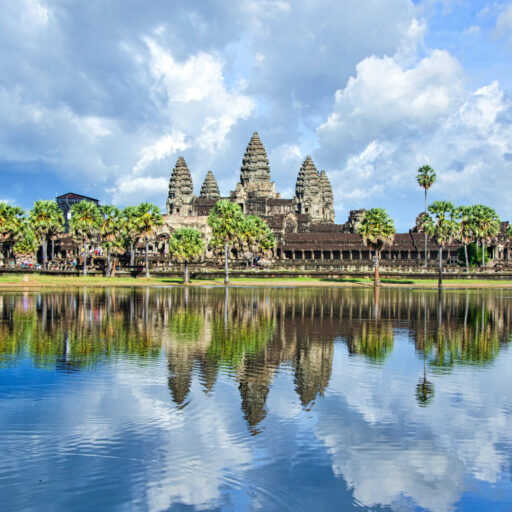Visiting Angkor Wat during Cambodia’s green season (roughly May to October) offers a unique and magical experience that many travelers overlook. Here’s why it’s considered one of the best times to explore the ancient temples:

1. Lush, Vibrant Landscapes
After the rains begin, the entire Angkor Archaeological Park transforms into a vivid green wonderland. The moats are full, the grass is lush, and the trees surrounding the temples burst with life. This creates a breathtaking contrast with the ancient stonework, perfect for photography and quiet reflection.

Tip: The famous reflecting pool in front of Angkor Wat is often full during this time, giving you a better chance at capturing that iconic mirror image.
2. Fewer Crowds
High season (November–March) draws large tourist crowds. In contrast, the green season brings fewer visitors, allowing you to explore the temples in peace, hear the natural sounds of the jungle, and enjoy more personal space at even the most popular spots like Bayon and Ta Prohm.
3. Soft Light and Moody Skies
The rainy season brings dramatic cloudscapes, golden sunrises, and soft, diffused light—ideal conditions for photographers. Early mornings after a night of rain often deliver crystal-clear air and some of the most atmospheric lighting you’ll ever see at Angkor Wat.

4. Cooler Temperatures (After Rain)
Though it’s humid, the rain often cools down the heat of the day. Early mornings and late afternoons are especially pleasant for temple exploration, without the scorching midday sun you’d face during the dry season.
5. Better Local Interaction & Deals
With tourism slightly quieter during the green season:
- Local guides and tuk-tuk drivers are more relaxed and available.
- Hotels and tours often offer off-season discounts.
- You’re more likely to experience authentic interaction with locals and avoid over-commercialized services.
6. A Sense of Renewal
The rain doesn’t just bring greenery—it brings spiritual energy. In Khmer culture, the green season is tied to rebirth, fertility, and cleansing, which enhances the already mystical feel of the temples. You’ll see monks and locals performing rituals as life flows back into the land.
☔ “Rainy Season” Misconception: It Doesn’t Rain All Day
Don’t be put off by the term rainy season. In reality, rain typically comes in short, dramatic bursts—often in the late afternoon or evening—leaving plenty of dry hours for sightseeing.

Pro tip: Start your day early to explore while the sky is clear, then relax in the afternoon if rain comes through.
🌄 Conclusion: A Hidden Gem of Timing
Angkor Wat in the green season offers a rare blend of beauty, tranquility, and intimacy with one of the world’s greatest wonders. If you’re looking for a more immersive, less crowded, and photogenically rich experience, this is the season when the temples truly feel alive.


Leave a Reply